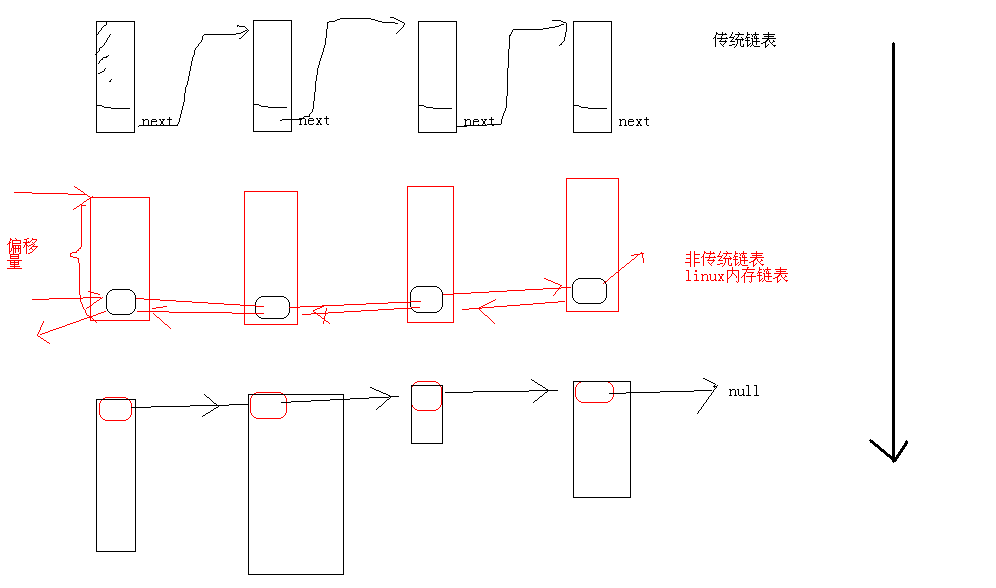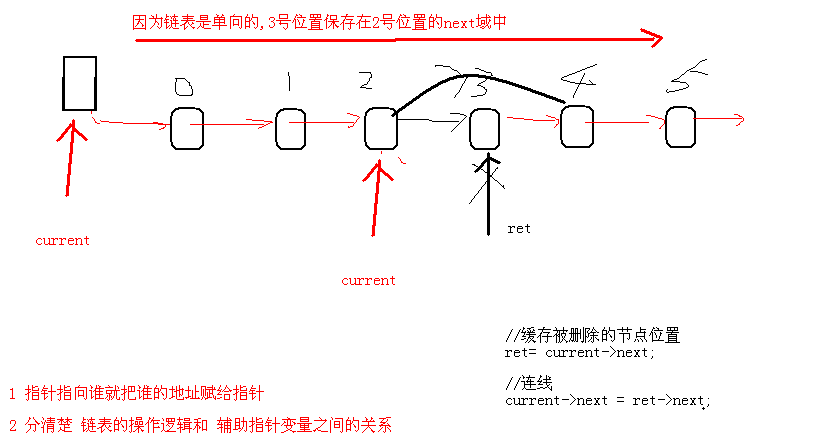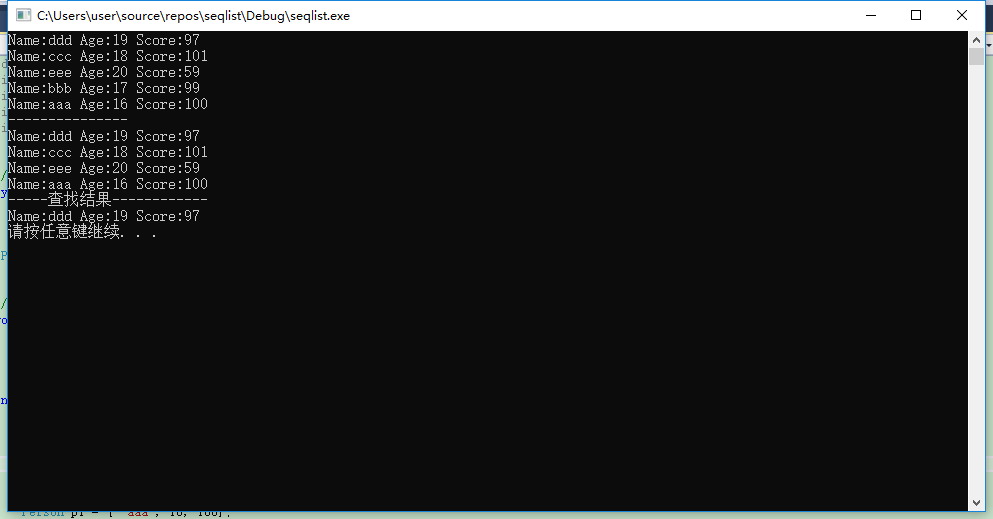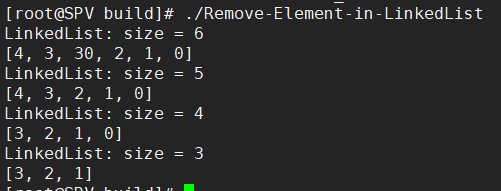前言:
这次介绍基本数据结构的线性表和链表,并用C语言进行编写;建议最开始学数据结构时,用C语言;像栈和队列都可以用这两种数据结构来实现。
一、线性表基本介绍
1 概念:
线性表也就是关系户中最简单的一种关系,一对一。
如:学生学号的集合就是一个线性表。
2 特征:
① 有且只有一个“首元素“。
② 有且只有一个“末元素”。
③ 除“末元素”外,其余元素均有唯一的后继元素。
④ 除“首元素”外,其余元素均有唯一的前驱元素。
3 存储划分:
① 如果把线性表用“顺序存储”,那么就是“顺序表”。
② 如果把线性表用“链式存储”,那么就是“链表”。
4 常用操作:
添加,删除,插入,查找,遍历,统计。
二、线性表实现
主要实现线性表的创建、销毁和插入等操作,将接口封装在.h文件中,如下:
#ifndef __MY_SEQLIST_H__ #define __MY_SEQLIST_H__ typedef void SeqList; typedef void SeqListNode; SeqList* SeqList_Create(int capacity); //创建线性表 void SeqList_Destroy(SeqList* list); //销毁 void SeqList_Clear(SeqList* list); //清空 int SeqList_Length(SeqList* list); //求线性表的长度 int SeqList_Capacity(SeqList* list); //求线性表的容量 int SeqList_Insert(SeqList* list, SeqListNode* node, int pos); //向线性表中插入元素 SeqListNode* SeqList_Get(SeqList* list, int pos); //获取指定位置元素 SeqListNode* SeqList_Delete(SeqList* list, int pos); //删除指定位置元素 #endif //__MY_SEQLIST_H__
注意:定义头文件时,要包含“#ifndef”,防止头文件重复包含!
1、线性表创建
主要就是对节点分配内存,代码如下:
//在结构体中套1级指针 // typedef struct _tag_SeqList { int length; int capacity; unsigned int *node; //int* node[] }TSeqList; SeqList* SeqList_Create(int capacity) { int ret = 0; TSeqList *tmp = NULL; tmp = (TSeqList *)malloc(sizeof(TSeqList)); if (tmp == NULL) { ret = -1; printf("func SeqList_Create() err:%d ", ret); return NULL; } memset(tmp, 0, sizeof(TSeqList)); //根据capacity 的大小分配节点的空间 tmp->node = (unsigned int *)malloc(sizeof(unsigned int *) * capacity); if (tmp->node == NULL) { ret = -2; printf("func SeqList_Create() err: malloc err %d ", ret); return NULL; } tmp->capacity = capacity; tmp->length = 0; return tmp; } void SeqList_Destroy(SeqList* list) { TSeqList *tlist = NULL; if (list == NULL) { return ; } tlist = (TSeqList *)list; if (tlist->node != NULL) { free(tlist->node); } free(tlist); return ; }
2、线性表插入
插入在业界有默认的规则吧,下面将要讲到的链表也是用这个规则。用图来讲解一下吧,如下:

讲解:例如,已经有线性表34、33、32、31,在1位置想插入35,想把从1开始的先后移,再插入,插入后的线性表如右图所示。
线性表插入代码如下:
int SeqList_Insert(SeqList* list, SeqListNode* node, int pos) { int i =0, ret = 0; TSeqList *tlist = NULL; if (list == NULL || node==NULL || pos<0) { ret = -1; printf("fun SeqList_Insert() err:%d ", ret); return ret; } tlist = (TSeqList*)list; //判断是不是满了 if (tlist->length >= tlist->capacity) { ret = -2; printf("fun SeqList_Insert() (tlist->length >= tlist->capacity) err:%d ", ret); return ret; } //容错修正 6个长度 容量20;用户pos10位置插入.. if (pos>=tlist->length) { pos = tlist->length; // } //1 元素后移 for(i=tlist->length; i>pos; i--) { tlist->node[i] = tlist->node[i-1]; //a[7] = a[6] } // i = 3 // 2插入元素 tlist->node[i] = (unsigned int )node; tlist->length ++; return 0; }
3、获取指定位置元素
根据pos位置获取元素,代码如下:
SeqListNode* SeqList_Get(SeqList* list, int pos) { int i =0; SeqListNode *ret = 0; TSeqList *tlist = NULL; if (list == NULL || pos<0) { printf("fun SeqList_Get() err:%d ", ret); return NULL; } tlist = (TSeqList*)list; ret = (void *)tlist->node[pos]; return ret; }
4、删除指定位置元素
将指定位置的元素进行删除,代码如下:
SeqListNode* SeqList_Delete(SeqList* list, int pos) { int i = 0; SeqListNode *ret = 0; TSeqList *tlist = NULL; if (list == NULL || pos<0) //检查 { printf("fun SeqList_Delete() err:%d ", ret); return NULL; } tlist = (TSeqList*)list; ret = (SeqListNode *)tlist->node[pos]; //缓存pos的位置 for (i=pos+1; i<tlist->length; i++) //pos位置后面的元素前移 { tlist->node[i-1] = tlist->node[i]; } tlist->length --; return ret; }
5、总体代码
整个seqlist.c代码如下,方便使用与调试:

#include <stdlib.h> #include <string.h> #include <stdio.h> #include "seqlist.h" //在结构体中套1级指针 // typedef struct _tag_SeqList { int length; int capacity; unsigned int *node; //int* node[] }TSeqList; SeqList* SeqList_Create(int capacity) { int ret = 0; TSeqList *tmp = NULL; tmp = (TSeqList *)malloc(sizeof(TSeqList)); if (tmp == NULL) { ret = -1; printf("func SeqList_Create() err:%d ", ret); return NULL; } memset(tmp, 0, sizeof(TSeqList)); //根据capacity 的大小分配节点的空间 tmp->node = (unsigned int *)malloc(sizeof(unsigned int *) * capacity); if (tmp->node == NULL) { ret = -2; printf("func SeqList_Create() err: malloc err %d ", ret); return NULL; } tmp->capacity = capacity; tmp->length = 0; return tmp; } void SeqList_Destroy(SeqList* list) { TSeqList *tlist = NULL; if (list == NULL) { return ; } tlist = (TSeqList *)list; if (tlist->node != NULL) { free(tlist->node); } free(tlist); return ; } //清空链表 //回到初始化状态 void SeqList_Clear(SeqList* list) { TSeqList *tlist = NULL; if (list == NULL) { return ; } tlist = (TSeqList *)list; tlist->length = 0; return ; } int SeqList_Length(SeqList* list) { TSeqList *tlist = NULL; if (list == NULL) { return -1; } tlist = (TSeqList *)list; return tlist->length; } int SeqList_Capacity(SeqList* list) { TSeqList *tlist = NULL; if (list == NULL) { return -1; } tlist = (TSeqList *)list; return tlist->capacity; } int SeqList_Insert(SeqList* list, SeqListNode* node, int pos) { int i =0, ret = 0; TSeqList *tlist = NULL; if (list == NULL || node==NULL || pos<0) { ret = -1; printf("fun SeqList_Insert() err:%d ", ret); return ret; } tlist = (TSeqList*)list; //判断是不是满了 if (tlist->length >= tlist->capacity) { ret = -2; printf("fun SeqList_Insert() (tlist->length >= tlist->capacity) err:%d ", ret); return ret; } //容错修正 6个长度 容量20;用户pos10位置插入.. if (pos>=tlist->length) { pos = tlist->length; // } //1 元素后移 for(i=tlist->length; i>pos; i--) { tlist->node[i] = tlist->node[i-1]; //a[7] = a[6] } // i = 3 // 2插入元素 tlist->node[i] = (unsigned int )node; tlist->length ++; return 0; } SeqListNode* SeqList_Get(SeqList* list, int pos) { int i =0; SeqListNode *ret = 0; TSeqList *tlist = NULL; if (list == NULL || pos<0) { printf("fun SeqList_Get() err:%d ", ret); return NULL; } tlist = (TSeqList*)list; ret = (void *)tlist->node[pos]; return ret; } SeqListNode* SeqList_Delete(SeqList* list, int pos) { int i = 0; SeqListNode *ret = 0; TSeqList *tlist = NULL; if (list == NULL || pos<0) //检查 { printf("fun SeqList_Delete() err:%d ", ret); return NULL; } tlist = (TSeqList*)list; ret = (SeqListNode *)tlist->node[pos]; //缓存pos的位置 for (i=pos+1; i<tlist->length; i++) //pos位置后面的元素前移 { tlist->node[i-1] = tlist->node[i]; } tlist->length --; return ret; }
6、调试
写一个main函数,进行上面的接口调用与调试,代码如下:
#include <stdlib.h> #include <string.h> #include <stdio.h> #include "seqlist.h" typedef struct _Teacher { int age; char name[64]; }Teacher; void main() { int ret = 0, i = 0; SeqList* list = NULL; Teacher t1, t2, t3, t4,t5; t1.age = 31; t2.age = 32; t3.age = 33; t4.age = 34; t5.age = 35; list = SeqList_Create(10); if (list == NULL) { printf("func SeqList_Create() ret :%d ", ret); return ; } ret = SeqList_Insert(list, (SeqListNode*) &t1, 0); //头插法 ret = SeqList_Insert(list, (SeqListNode*) &t2, 0); //头插法 ret = SeqList_Insert(list, (SeqListNode*) &t3, 0); //头插法 ret = SeqList_Insert(list, (SeqListNode*) &t4, 0); //头插法 ret = SeqList_Insert(list, (SeqListNode*) &t5, 1); //头插法 //遍历 for (i=0; i<SeqList_Length(list); i++) { Teacher* tmp = (Teacher *) SeqList_Get(list, i); if (tmp == NULL) { return ; } printf("tmp->age:%d ", tmp->age); } //删除链表中的节点 while( SeqList_Length(list) > 0 ) { SeqList_Delete(list, 0); } system("pause"); return ; }
三、链表
1、介绍
链表的大体有三种实现方式,用图进行讲解吧,如下图:

说明:最上面就是最传统链表,每个节点存一个next指针,保存下一个节点的地址
中间是linux内核实现的链表,一般是双向链表,有一个缺点要记录偏移量
最后是改进之后的链表,不需要记录偏移量,这是前人的智慧,我将采用最后一种进行实现。
2、定义头文件
头文件主要包含结构体定义,和接口声明,主要实现链表初始化、插入、遍历等操作,头文件如下:
#ifndef LINKLIST_H #define LINKLIST_H #include<stdlib.h> #include<stdio.h> //链表结点 typedef struct LINKNODE{ void* data; //指向任何类型的数据 struct LINKNODE* next; }LinkNode; //链表结构体 typedef struct LINKLIST{ LinkNode* head; int size; }LinkList; //定义函数指针 typedef void(*PRINTLINKNODE)(void*); //初始化链表 LinkList* Init_LinkList(); //指定位置插入 void Insert_LinkList(LinkList* list,int pos,void* data); //删除指定位置的值 void RemoveByPos_LinkList(LinkList* list, int pos); //获得链表的长度 int Size_LinkList(LinkList* list); //查找 int Find_LinkList(LinkList* list,void* data); //返回第一个结点 void* Front_LinkList(LinkList* list); //打印链表结点 void Print_LinkList(LinkList* list, PRINTLINKNODE print); //释放链表内存 void FreeSpace_LinkList(LinkList* list); #endif
3、插入节点
初始化链表跟线性表类似,就不在过多说明了,主要讲解插入和删除节点,对插入节点进行讲解,如下图:

说明:需要两个指针current、node,假如在3号位置进行插入,要先处理node->next,node指向3号位置,就把3号位置指针付给它,node->next=current->next;
2号位置指向node,把node指针赋值给它,current->next=node;
注意:图片左下角的红字,是理解链表插入、删除等的关键!
代码如下:
//指定位置插入 void Insert_LinkList(LinkList* list, int pos, void* data){ if (list == NULL){ return; } if (data == NULL){ return; } //友好的处理,pos越界 if (pos < 0 || pos > list->size) { pos = list->size; } //创建新的结点 LinkNode* newnode = (LinkNode*)malloc(sizeof(LinkNode)); newnode->data = data; newnode->next = NULL; //找结点 //辅助指针变量 LinkNode* pCurrent = list->head; for (int i = 0; i < pos;i++){ pCurrent = pCurrent->next; } //新结点入链表 newnode->next = pCurrent->next; pCurrent->next = newnode; list->size++; }
4、删除节点

说明:
删除3号位置,先保存被删除节点的位置,再将2直接指向4;
5、整体代码
整个的代码,方便大家使用和调试,代码如下:

#include"LinkList.h" //初始化链表 LinkList* Init_LinkList(){ LinkList* list = (LinkList*)malloc(sizeof(LinkList)); list->size = 0; //头结点 是不保存数据信息 list->head = (LinkNode*)malloc(sizeof(LinkNode)); list->head->data = NULL; list->head->next = NULL; return list; } //指定位置插入 void Insert_LinkList(LinkList* list, int pos, void* data){ if (list == NULL){ return; } if (data == NULL){ return; } //友好的处理,pos越界 if (pos < 0 || pos > list->size) { pos = list->size; } //创建新的结点 LinkNode* newnode = (LinkNode*)malloc(sizeof(LinkNode)); newnode->data = data; newnode->next = NULL; //找结点 //辅助指针变量 LinkNode* pCurrent = list->head; for (int i = 0; i < pos;i++){ pCurrent = pCurrent->next; } //新结点入链表 newnode->next = pCurrent->next; pCurrent->next = newnode; list->size++; } //删除指定位置的值 void RemoveByPos_LinkList(LinkList* list, int pos){ if (list == NULL){ return; } if (pos < 0 || pos >= list->size){ return; } //查找删除结点的前一个结点 LinkNode* pCurrent = list->head; for (int i = 0; i < pos;i ++){ pCurrent = pCurrent->next; } //缓存删除的结点 LinkNode* pDel = pCurrent->next; pCurrent->next = pDel->next; //释放删除结点的内存 free(pDel); list->size--; } //获得链表的长度 int Size_LinkList(LinkList* list){ return list->size; } //查找 int Find_LinkList(LinkList* list, void* data){ if (list == NULL){ return -1; } if (data == NULL){ return -1; } //遍历查找 LinkNode* pCurrent = list->head->next; int i = 0; while (pCurrent != NULL){ if (pCurrent->data == data){ break; } i++; pCurrent = pCurrent->next; } return i; } //返回第一个结点 void* Front_LinkList(LinkList* list){ return list->head->next->data; } //打印链表结点 void Print_LinkList(LinkList* list, PRINTLINKNODE print){ if (list == NULL){ return; } //辅助指针变量 LinkNode* pCurrent = list->head->next; while (pCurrent != NULL){ print(pCurrent->data); pCurrent = pCurrent->next; } } //释放链表内存 void FreeSpace_LinkList(LinkList* list){ if (list == NULL){ return; } //辅助指针变量 LinkNode* pCurrent = list->head; while (pCurrent != NULL){ //缓存下一个结点 LinkNode* pNext = pCurrent->next; free(pCurrent); pCurrent = pNext; } //释放链表内存 list->size = 0; free(list); }
6、调试代码
写一个main函数进行调试,如下:

#define _CRT_SECURE_NO_WARNINGS #include <stdio.h> #include <stdlib.h> #include <string.h> #include "LinkList.h" //自定义数据类型 typedef struct PERSON{ char name[64]; int age; int score; }Person; //打印函数 void MyPrint(void* data){ Person* p = (Person*)data; printf("Name:%s Age:%d Score:%d ",p->name,p->age,p->score); } int main(void){ //创建链表 LinkList* list = Init_LinkList(); //创建数据 Person p1 = { "aaa", 16, 100}; Person p2 = { "bbb", 17, 99 }; Person p3 = { "ccc", 18, 101 }; Person p4 = { "ddd", 19, 97 }; Person p5 = { "eee", 20, 59 }; //数据插入链表 Insert_LinkList(list, 0, &p1); Insert_LinkList(list, 0, &p2); Insert_LinkList(list, 0, &p3); Insert_LinkList(list, 0, &p4); Insert_LinkList(list, 2, &p5); //打印 Print_LinkList(list, MyPrint); //删除3 RemoveByPos_LinkList(list, 3); //打印 printf("--------------- "); Print_LinkList(list, MyPrint); //返回第一个结点 printf("-----查找结果------------ "); Person* ret = (Person*)Front_LinkList(list); printf("Name:%s Age:%d Score:%d ", ret->name, ret->age, ret->score); //销毁链表 FreeSpace_LinkList(list); system("pause"); return 0; }
运行结果如下,供参考:

四、补充C++实现链表
1、头文件
头文件LinkedList.h,代码如下:

#include <iostream> template<class T> class Node { //节点类 public: T e; //数据域 Node *next; //指针域 Node(T e, Node *next) : e(e), next(next) { //构造函数的列表初始化 } Node(T e) : e(e), next(nullptr) { } Node() : next(nullptr) { //无参构造函数 } }; template<class T> class LinkedList { private: Node<T> *head; //头结点 int size; public: class Range { }; class Empty { }; LinkedList() { //构造函数 head = new Node<T>(); size = 0; } int getSize() { //获取大小 return size; } bool isEmpty() { //判断是否为空 return size == 0; } void add(int index, T e) { //指定位置插入元素 if (index < 0 || index > size) { throw Range(); } Node<T> *prev = head; for (int i = 0; i < index; ++i) { prev = prev->next; } prev->next = new Node<T>(e, prev->next); size++; } void addFirst(T e) { //插入元素 头插法 add(0, e); } void addLast(T e) { //插入元素 尾插法 add(size, e); } T get(int index) { //获取元素 if (size == 0) { throw Empty(); } if (index < 0 || index >= size) { throw Range(); } Node<T> *cur = head->next; for (int i = 0; i < index; ++i) { cur = cur->next; } return cur->e; } T getFirst() { return get(0); } T getLast() { return get(size - 1); } void set(int index, T e) { if (size == 0) { throw Empty(); } if (index < 0 || index >= size) { throw Range(); } Node<T> *cur = head->next; for (int i = 0; i < index; ++i) { cur = cur->next; } cur->e = e; } void setFirst(T e) { set(0, e); } void setLast(T e) { set(size - 1, e); } T remove(int index) { //删除指定位置元素 if (index < 0 || index >= size) { throw Range(); } if (size == 0) { throw Empty(); } Node<T> *prev = head; for (int i = 0; i < index; ++i) { prev = prev->next; } Node<T> *retNode = prev->next; prev->next = retNode->next; retNode->next = nullptr; size--; return retNode->e; } T removeFirst() { return remove(0); } T removeLast() { return remove(size - 1); } void removeElement(T e) { Node<T> *prev = head; while (prev->next != nullptr) { if (prev->next->e == e) { break; } prev = prev->next; } if (prev->next != nullptr) { Node<T> *delNode = prev->next; prev->next = delNode->next; delNode->next = nullptr; size--; } } bool contains(T e) { //是否包含 Node<T> *cur = head; for (int i = 0; i < size; ++i) { cur = cur->next; if (cur->e == e) { return true; } } return false; } void print() { //打印输出 Node<T> *prev = head; std::cout << "LinkedList: size = " << size << std::endl; std::cout << "["; for (int i = 0; i < size; ++i) { prev = prev->next; std::cout << prev->e; if (i < size - 1) { std::cout << ", "; } } std::cout << "]" << std::endl; } };
2、main函数
main.cpp如下:
#include <iostream> #include "LinkedList.h" int main() { LinkedList<int> *linkedList = new LinkedList<int>(); for (int i = 0; i < 5; ++i) { linkedList->addFirst(i); //头插法 } linkedList->add(2, 30); //指定位置插入元素 linkedList->print(); //打印输出 linkedList->remove(2); //删除指定位置元素 linkedList->print(); linkedList->removeFirst(); linkedList->print(); linkedList->removeLast(); linkedList->print(); return 0; }
3、测试
运行结果如下:

总结
虽然线性表和单向链表是数据结构的基础,但完全掌握之后,再学习栈、队列等数据结构将会得心应手;
喜欢的希望帮忙点赞,不懂的欢迎随时留言!
